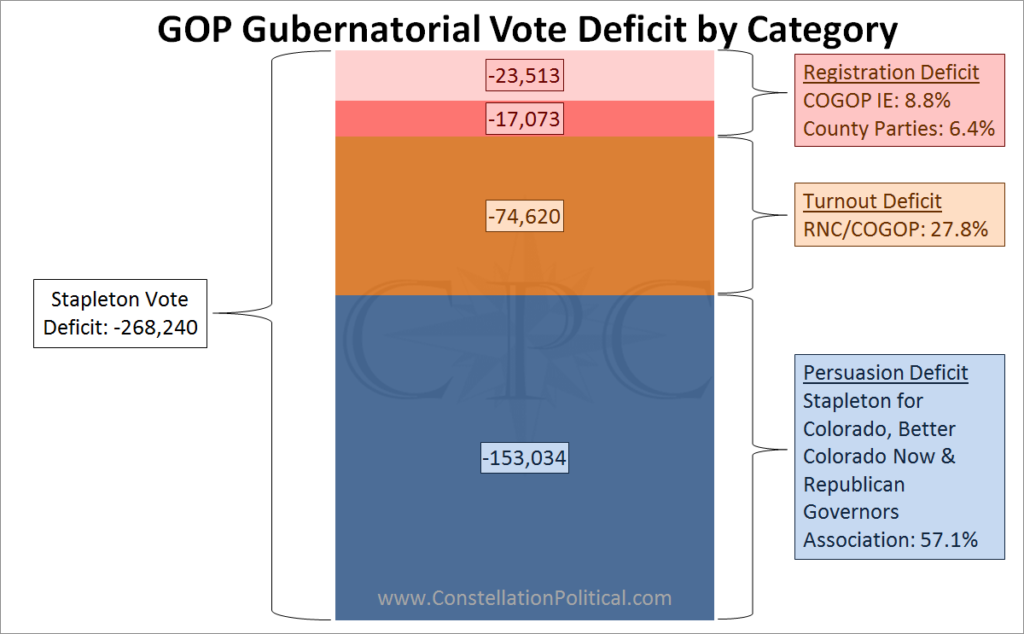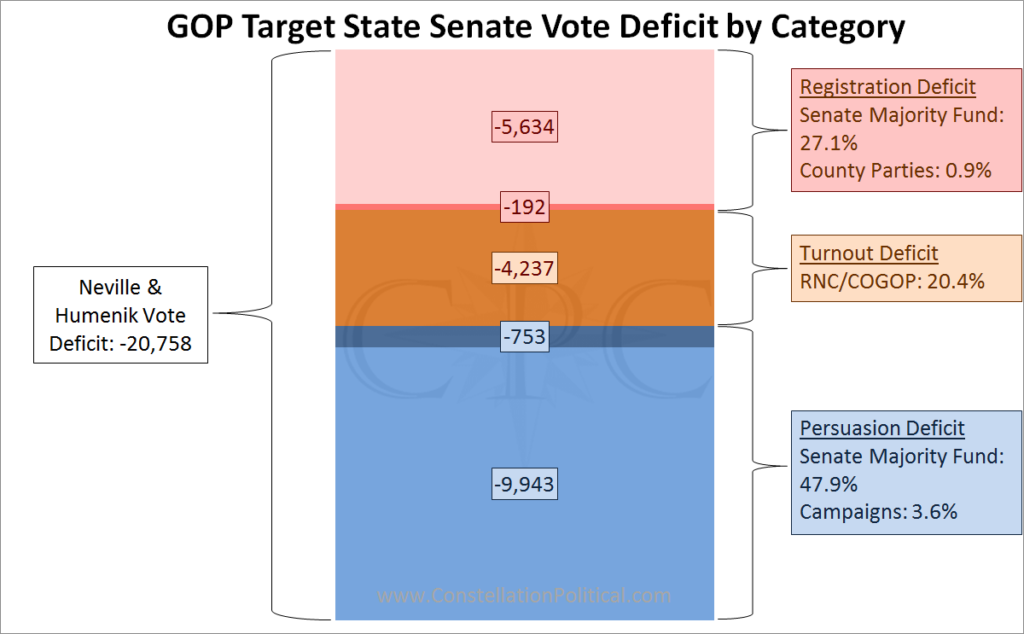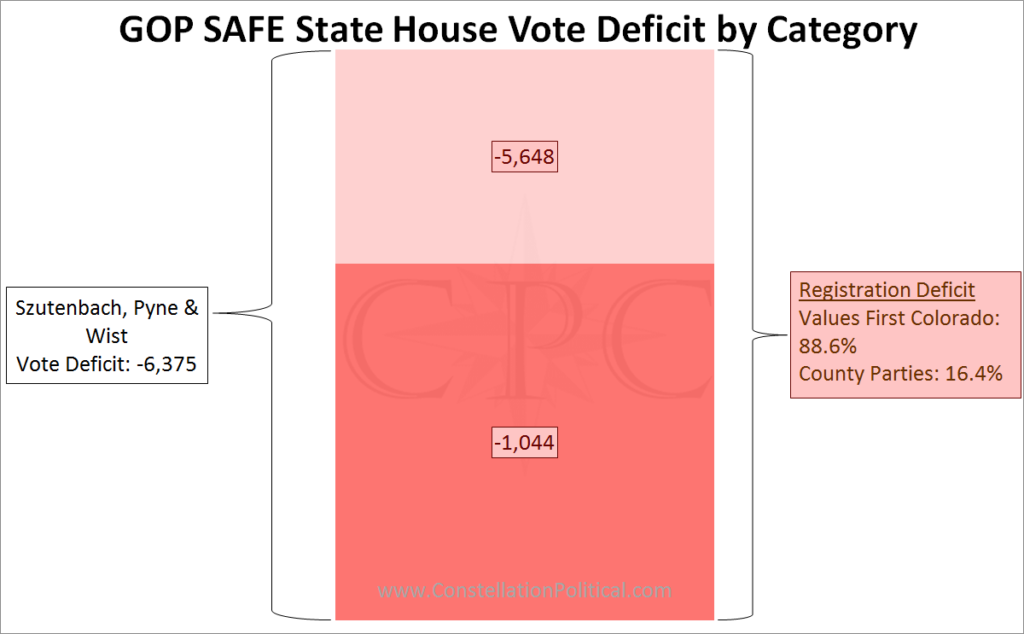 The Mathematics of Blame
The Mathematics of Blame
In the wake of the disastrous defeat that Colorado Republicans suffered this year, people are in a frenzy to lay the blame on someone. But, who or what is actually to blame for the Republican defeat?
Election outcomes are determined by registration, turnout and persuasion.
Independent Expenditure Committees & County Parties are responsible for registration.
The State Party/Republican National Committee is responsible for turnout.
The campaigns and their Independent Expenditure Committees are responsible for persuasion.
Most of our defeat in the Gubernatorial race can be attributed to the Stapleton Campaign and supporting Independent Expenditure Committees.
Most of our defeat in the State Senate can be attributed to the Senate Majority Fund.
Most of our defeat in the State House can be attributed to Values First Colorado.
A lot of folks seemed to interpret my post about the role of the Colorado Republican Party as an attempt to absolve them of all guilt for the outcome of this year’s election. My goal was simply to make sure people understood the role of the State Party and the State Chair before that election takes place this Spring.
But people seem pretty keen to lay blame for the Republican defeat… so let’s do that.
Here is the mathematical breakdown of who is to blame for the Republican defeat this year:
Election Outcome Components
When broken down into their most basic elements, elections are pretty simple. You just need one thing: more votes than the other guy.
You can break total votes into three parts: you need people who will definitely vote for your candidate, you need them to actually vote, and you need to convince enough of the rest of ’em to come your way to make up the deficit.
This corresponds to three activities: voter registration, voter turnout and persuasion.
Voter Registration
Voter registration is tough. I’ve been harping on this for years, and our registration advantage over the Democrats has only deteriorated. Just look at it:

Who is in charge of registration? The knee-jerk reaction is to say that the State Party should be in charge of this. But, if you’ve read my post on the role of the State Party and if you know something about the logistics and cost involved with a Statewide voter registration effort, then you know it’s not feasible to expect the State Party to undertake this effort.
There are two groups that are well positioned to run our voter registration efforts: the Colorado GOP Independent Expenditure Committee and the County Republican Parties.
Before you go into meltdown about my apparent contradiction there let me tell you: the law forbids the State Party from coordinating, directing, or even being aware of what the Independent Expenditure Committee is up to. Despite the name, in practice they are wholly separate operations.
Voter registration should be where county parties live. It requires only a small effort, but that effort has to be applied consistently nonetheless. Have a few volunteers who want to stand at the County Party booth at a farmers market? You’ve got a registration effort.
Turnout
My State Party Primer contains more details on this, but in summary, the RNC gives the Colorado Republican Party a lot of money to conduct their joint turnout operations. This has nothing to do with any one campaign, it’s just about harassing registered Republicans until they return their ballots. This is something the State Party/RNC are wholly responsible for.
A good turnout operation should be able to produce a 3-5 point turnout advantage over the Democrats. In Colorado we’re even better at it, and over the cycles preceding this one we’ve averaged a 6.3 point advantage. This year: 0.2 points…
Persuasion
This is everything else. Someone has to convince at least some Unaffiliated voters to vote for our candidates. This is the chief responsibility of the candidate’s campaign. The campaigns are backed up by Independent Expenditure Committees, 527’s, SuperPACs — call them whatever you want. These outside entities are there to persuade Unaffiliated voters to either vote for our candidate or, at the very least, against the other.
Breaking It Down- The Gubernatorial Race
So how does that apply to Colorado? Let’s apply the responsibilities listed above to our Gubernatorial effort, the top of the ticket this year.

Let’s go through Graph 2 piece by piece.
The box on the far left shows difference between the raw number of votes that Stapleton and Polis each received. The columns in the middle are broken down by type of electioneering activity. Blue is persuasion, orange is turnout and red is voter registration. The numbers in the middle show the number of votes for Stapleton that each of those activities should have generated. The colored boxes on the right show the organizations responsible for each activity and the percentage of Stapleton’s vote deficit that they accounted for.
The Republican voter registration advantage has been slipping since 2014. Let’s assume that the State Party Independent Expenditure Committee and the County Parties proactively registered enough Republican voters to simply hold steady from 2014. We can divide the IE and the County Party responsibility for that registration goal by the respective size of their budgets. The cumulative sum of the largest counties’ budgets represents about 42% of that pool and the IE gets 58% of this goal. As a result, the the ColoGOP IE accounted for a total of 8.8% of our vote deficit and the combined county Republican parties accounted for 6.4%. The lack of a voter registration effort accounted for a 40,586 vote deficit for Stapleton or 15.2% of his total loss.
If we’d had the same kind of turnout margin above the Democrat’s that we typically do, we’d have picked up another 74,620 votes for Stapleton. So the RNC/State Party is on the hook for 27.8% of Stapleton’s loss for failing to turn out our voters.
The largest chunk – persuasion. If we had kept registration and turnout unchanged from our last victorious year, Stapleton would have still been short by 153,034 votes. 57.1% of the total vote deficit would have had to be made up by the Stapleton campaign and outside persuasion entities like their Independent Expenditure Committee and the Republican Governor’s Association.
Breaking It Down – The State Senate
We also lost the State Senate. There were two seats we had to hold to prevent this. We can apply the same analysis that we applied to the Gubernatorial race to these races. Tim Neville and Beth Humenik lost by a cumulative 20,758 votes in their two races.

In the case of the State Senate, the main driver is an organization called the Senate Majority Fund. They’re also the only outfit at the State Senate level capable of mounting a significant voter registration effort. Again, let’s assume the county parties that overlap these two State Senate races helped with registration. Let’s also assume that Adams County and Jefferson County focused all their voter registration efforts in one Senate district each. We’ll again split the responsibility for the registration goal by the relative size of their budgets.
Just keeping voter registration steady from 2014 in these districts would have made up 5,825 votes or 28.1% of our deficit. Senate Majority Fund would have been accountable for 27.1% of the vote deficit. The Jefferson and Adams County Republican parties combined should have shouldered 0.9% of the deficit.
The State Party is still responsible for turnout. If our turnout advantage over the Democrats had been the same as it was in 2014, that would have made up 4,237 votes or 20.4% of our total vote deficit.
The remainder falls to persuasion. In the case of the State Senate, the Senate Majority Fund is also the major vehicle of persuasion. SMF and these two campaigns combined had to make up 10,695 more votes through persuasion. If we weight their responsibility for those votes by the total size of their budgets, this means the campaigns were responsible for 3.6% of the total vote deficit and Senate Majority Fund was responsible for an additional 47.9% of the total deficit via the persuasion shortfall.
Between voter registration and persuasion the Senate Majority Fund was responsible for 75% of the vote deficit in the two State Senate races that cost us the majority.
I don’t mention this to call out SMF. I mention it because, admit it, you’ve never even heard of the Senate Majority Fund.
Breaking It Down – The State House
For those of you looking for something to actually be outraged about – this is it.
In addition to losing a host of competitive races this year, we lost three safe State House Seats.
We lost these seats by a total of 6,375 votes.

The State House equivalent of Senate Majority Fund is an organization called Values First Colorado. On the State House side it is the only organization big enough to launch a major voter registration effort. If we assume that they shared the load of registering voters with the county parties according to the size of their budgets, we see that the Arapahoe and Jefferson County Republican Parties are responsible for 16.4% of the vote deficit in previously safe House seats, and that Values First Colorado is responsible for 88.6% of the vote deficit.
And yes, that does total to more than 100%.
Had we simply held voter registration in these districts steady from 2014 it would have been enough to hold on to them. We wouldn’t have had to make any improvement in either turnout or persuasion relative to their past performance. We could have held them with voter registration alone.
And I bet you’ve never heard of Values First Colorado either.
Conclusion
Now that you know who to blame for the Republican defeat and by how much I’m sure you’re feeling better. And if not…
Maybe it’s because the reality is that we here in our little corner of the country were pushing against a national headwind. Yeah, there’s plenty of blame to go around. But before you start hurling accusations, take the time to consider that this was a tough cycle and our Republican organizations failed across the board.
While this post is glib about who to blame for this mess, read the correct way, it’s also a map that shows what we need to focus on in the next two years if we’re going to avoid a repeat performance.